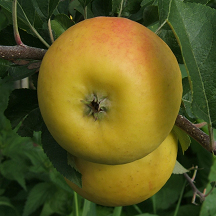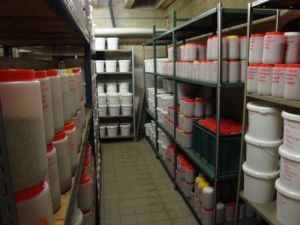Inventory of CRA-W collections
The Walloon Agricultural Research Centre owns, maintains and develops a large number of collections. These require a lot of work, sometimes involving specific conservation conditions (low temperature, conservation in a medium, under a controlled atmosphere, etc.). Living collections have to be reproduced, grafted, tended, and so on. These are essential tasks in order to conserve these important resources. The range of current or potential applications is wide. Much of the time, however, this work goes on without external backing, using own funding and away from the public eye. The people in charge of these collections do their vital work unseen. The purpose of this dossier is to put the spotlight on them, for once.
CRA-W holds by far the biggest collections of plant genetic resources in Belgium.
Plant genetic resources are an invaluable asset for the future of agriculture and human society. In view of their significance as a historical, scientific and economic asset and as they do not qualify for protection under intellectual property laws, their management is a basic task for the Public Service. Many old varieties are currently the subject of research and development projects aiming to enhance their economic and agronomic aspects, their disease resistance and their dietary and nutritional properties that are beneficial to human health. In addition, several breeding programmes run by CRA-W (spelt, wheat, apples, potatoes, pears, etc.) actively develop the germplasm collections managed by this institution, some of which are very original.
Our work also enjoys a high profile internationally, both as players in the European Cooperative Programme for Plant Genetic Resources (ECPGR), of which we are currently National Coordinator, and as managers of a European database, but also because of our dynamic approach to developing fruit tree, spelt, potato and cherry tree dwarfing rootstock germplasm. All these aspects therefore militate in favour of continuing and stepping up our activities directed at ever more effectively managing this tremendous heritage handed down to us by several generations of farmers and researchers.
- Standard tree collection producing budwood and rootstock with vegetative propagation forming virus-free and phytoplasma-free base material for fruit growing
- Prunus avium and cerasus collection (sweet and sour cherries)
- Ornamental Prunus collection
- Fungus collection
- Plant pathogenic bacteria collection
- Cereal sample collection
- Compound feed ingredient collection
- Fruit tree collection
Standard tree collection producing budwood and rootstock with vegetative propagation forming virus-free and phytoplasma
Diversity of collection :
As regards standard trees CRA-W maintains, tests and distributes 157 different strains or clones of fruiting and ornamental varieties, including the indicators used for biological indexing (46 cherry trees, 27 pear trees, 47 apple trees and 37 plum trees). The rootstock material comprises 1 cherry tree, 10 apple trees, 3 plum trees and 4 pear trees
Scope of collection:
The number of layered parent plants is adapted to suit the needs of the industry and internal use at CRA-W (nursery and biological indexing). It varies from a minimum of 10 plants for secondary strain or clone conservation to 280 parent plants for the commonest varieties. The whole layering bed extends to 1,150 linear metres, or 2,315 plants.
The need to rationalise the work has reduced the number of plants available in-house to one per clone or strain offered, except for the varieties used as indicators in biological indexing. The current total is 204 trees.
Year of creation: 1963
Initially established at Sombreffe and Mussy-La-Ville, the collection was then maintained at Mussy-La-Ville and Libramont in order to have reserves available in case of problems and to maintain a distance from the production areas, for phytosanitary reasons. The plots currently in production were established from 2002 onwards, in accordance with the Regional Government's specifications and subject to that body's approval.
Conservation conditions:
The material is maintained in an open-air conservation orchard or in a layering bed. The rooted layers and budwood are cut back annually to provide young material for vegetative propagation.
Current applications:
Provides quality starting material to propagators (nuclear stock orchards, nurseries), research institutions and other bodies. The material produced is also used forself-testing of the entire conservation operation (SPG, varieties, indicators) and for testing other varieties on behalf of third parties.
This material is also used in tests to improve biological testing procedures, in particular in greenhouses.
Contact: Jean-Louis Rolot, rolot@cra.wallonie.be
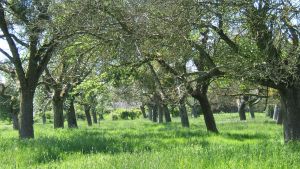
- Prunus avium and cerasus collection (sweet and sour cherries)
Diversity of collection:
236 sweet cherry accessions and 23 sour cherry accessions
Scope of collection:
3 replications
Year of creation: 1965
Conservation conditions:
The oldest accessions were regrafted between 2004 and 2008. The collection now totals 259 accessions
Current applications:
Variety assessment, biodiversity conservation and control for guaranteed identity.
147 varieties are described in the variety list 'The cherry in intensive orchards', 1996 edition revised in 2000 and again in 2007.
Potential applications:
Study of variety diversity, breeding
Collection notified to ECPGR Prunus
Contact: Hugo Magein, magein@cra.wallonie
Ornamental Prunus collection
Diversity of collection:
120 accessions
Scope of collection:
3 replications
Year of creation: 1965
Established by Monin and Tréfois with a view to selecting candidates for breeding dwarfing rootstock for sweet and sour cherry trees.
Conservation conditions:
Regrafted between 2004 and 2008, the collection still comprises 120 accessions today.
Current applications:
Rootstock selection, biodiversity conservation. Spectacular flowering variation.
Potential applications:
Study of ornamental diversity, breeding.
Collection notified to ECPGR Prunus
Contact: Hugo Magein, magein@cra.wallonie.be
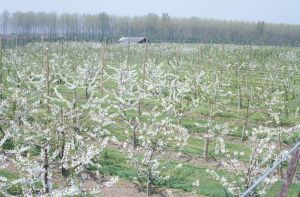
Fungus collection
Diversity of collection:
28 genera
Scope of collection:
Approx. 1,700 accessions
Year of creation: 2002
Conservation conditions:
in oil, 4°C and 55-60% RH
in water, 13°C, refrigerated incubator.
Current applications:
Used in research and service activities (quarantine strains used in the work of the FASFC plant disease NRL).
Creation of a database for computerised management (form used to characterise strains in the collection).
Contact: Anne Chandelier, chandelier@cra.wallonie.be
plant pathogenic bacteria collection
Diversity of collection:
1930 isolates
Scope of collection:
1,175 Pseudomonas syringae classed as 62 pathovars or indeterminate pathovar, 34 Pseudomonas viridiflava, 1 Pseudomonas agarici, 2 Pseudomonas asplenii, 3 Pseudomonas aureofaciens, 4 Pseudomonas chlororaphis, 3 Pseudomonas cichorii, 1 Pseudomonas ficuserectae, 9 Pseudomonas fluorescens, 15 Pseudomonas fuscovaginae, 2 Pseudomonas marginalis, 4 Pseudomonas putida, 501 Pseudomonas sp., 79 Erwinia amylovora, 1 Erwinia chrysanthemi, 5 Xanthomonas arboricola classés dans 3 pathovars, 1 Xanthomonas campestris, 49 Xanthomonas fragariae, 8 Xanthomonas sp, 10 Escherichia coli, 4 Rhizodium radiobacter, 1 Rhizodium rhizogenes, 1 Acidovorax valerianellae, 18 strains to be characterised
Year of creation: First strains isolated in 1993
The plant pathogenic bacteria collection started with specific bacteriological research begun in 1993 in response to concrete problems occurring in production orchards. Since then it has grown in step with the development of bacteriological research subjects, chiefly Pseudomonas syringae, as well as the quarantine bacteria Erwinia amylovora and Xanthomonas fragariae. For historical reasons there are therefore a large number of Pseudomona fluorescens strains.
Conservation conditions:
In glycerol in freezers at -80°C
Current applications:
Les Nouvelles de l'Agriculture, 2008, 46:34-35, Diseases caused by Pseudomonas syringae in production orchards, by A. Bultreys, V. Gilbert and F. Legros.
CRA-W Info, 2007, 15:3, What future for the horse chestnut tree in Belgium, by A. Bultreys.
The collection has been notified to FASFC for the quarantine bacteria aspects; COST 864 for the Erwinia amylovora aspects and COST 873 for the Pseudomonas syringae aspects deriving from stone fruit varieties.
Source of funding:
Department of Agriculture, Natural Resources and the Environment (DGARNE) for establishment of characterisation of production orchard pathogen collections (subsidies 2361, 2654, D31-1080, D31-1124). Ministry of Small Enterprises, Traders and Agriculture, for characterisation of production orchard pathogen collections (subsidy S 6081). Brussels-Capital Regional Government, Roads Department, for a -80°C freezer and establishment of characterisation of the chestnut tree collections (agreement B1/CNV/2007.0010)
Contact: Alain Bultreys, bultreys@cra.wallonie.be
Cereal sample collection
Diversity of collection:
Wheat and barley varieties tested since 2004 as part of Belgian catalogue accession testing
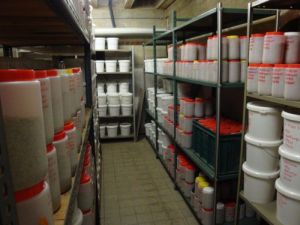
Scope of collection:
5 lots of 40 wheat varieties tested at 9 Belgian localities from 2004 up to now
5 lots of 20 barley varieties tested at 7 Belgian localities from 2004 up to now
Year of creation: 2004
Samples obtained from the plant accession testing organised by the Crop Production Department and conserved for analysis
Conservation conditions:
Conserved in a sealed 800 g plastic pot in a cellar at ambient temperature
Current applications:
- Development of methods for assessing wheat quality
- Cereal species discrimination in the context of FoodIntegrity project
- Infrared spectroscopy analysis services
Contact: Georges Sinnaeve, g.sinnaeve@cra.wallonie.be et Philippe Vermeulen, p.vermeulen@cra.wallonie.be
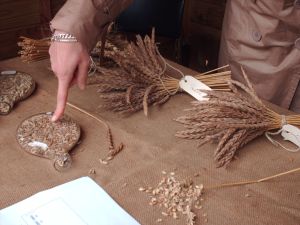
Compound feed ingredient collection
Diversity of collection:
All types of plant, mineral and industrially derived ingredients including MBM likely to be used in compound animal feed
Scope of collection:
Compound feed: 1100
Fish meal: 250
Terrestrial animal meal (mammals and birds): 500
Other ingredients: 150
TOTAL: 2,000
Year of creation: 1998
Conservation conditions:
Conserved in a cold store (4°C) and freezers (-20°C)
Current applications:
EURL-AP : characterisation and determination by optical microscopy, near infrared, PCR, immuno assay
SAFEEPAP: development and research into new markers for detection by optical and infrared microscopy of processed animal proteins, infrared microscopy quantification, development of immunological and PCR methods
Potential applications:
Participation in animal feed quality control projects (e.g. in the context of BSE) and NIRM characterisation. This collection is generally considered to be the only one of its kind in the world and is recognised by the sector. Research involving the use of large numbers ofingredient samples (in particular MBM) or comparison of samples.
Source of funding:
EURL-AP project (European Commission), internal funding
Contact: Pascal Veys, p.veys@cra.wallonie.be et Vincent Baeten, baeten@cra.wallonie.be

Fruit tree collection
Diversity of collection: 3,400 different individuals
Scope of collection: 3 samples per type
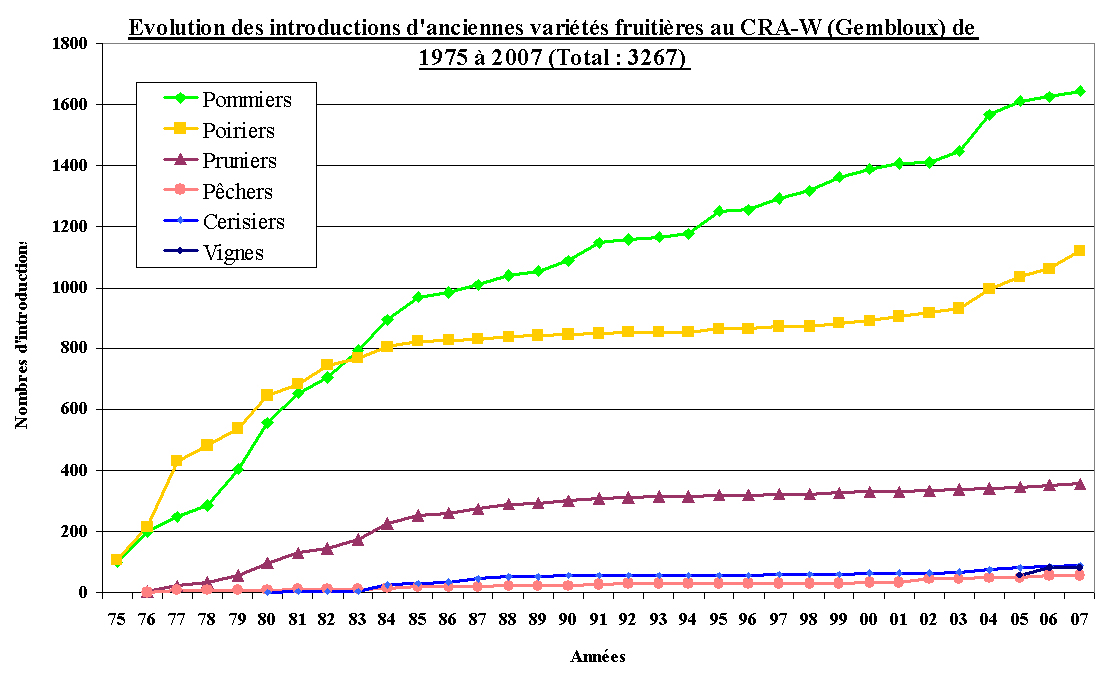

Figure caption
CRA-W (Gembloux) old fruit tree variety accession trend, 1975-2007 (Total: 3,267)
Number of accessions
Year
Apple trees
Pear trees
Plum trees
Peach trees
Cherry trees
Vines
Year of creation: 1975
Started by Charles Populer gathering a diversity of disease resistance characteristics, the collection has grown considerably as a result of enthusiastic public response. The collection is increased each year by inclusion of varieties discovered when identifying fruit brought in by the public.
Conservation conditions:
The collection is conserved in in situ and ex situ orchards forming a structured network throughout Wallonia.
Current applications:
-characterisation of disease resistance,
-hybridisation programme,
-development via the nursery and fruit tree sector,
- use in research, e.g. study of induced resistance in the apple tree ,
- study of plant health protection in an organic orchard,
- pear tree variety resistance to pear rust.
Source of funding:
Regional Government, DGARNE.
Collection notified to ECPGR; Bioversity International
Contact: Marc Lateur, lateur@cra.wallonie.be
